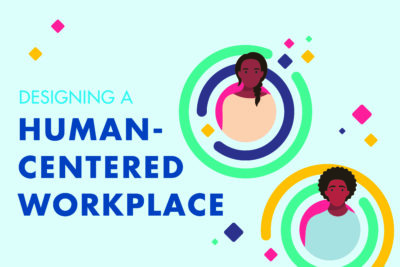How do you attract and keep workers? Include them in the job design process.
Today, even after a year of the fastest labor market recovery in history, there are still 11 million job openings. Every one of those open positions represents a choice. Employers can start to close this labor shortage by creating quality jobs that pay well and are supportive and fulfilling. But how do you create a job like that? What we propose is that you ask your workers, and in fact engage them in the effort to improve and re-design their own jobs.
There’s a name for this approach, one that operates at the intersection of leadership, equity, and creativity. It’s called human-centered design, or HCD for short. HCD is based on the observation that the people closest to a problem often have the clearest ideas about how to solve it. And today the National Fund is excited to announce our new tool Designing a Human-Centered Workplace: A Guide for Employers.
As we’ve said before, the best way to attract and retain frontline workers is to center them in the process of designing better jobs. Our new guide will make it easier for employers to do just that. It’s a digital road map for winning the competition for talent and navigating the post-COVID-19 labor crisis. It was developed in partnership with Design Impact, a social innovation nonprofit, with support from the Workforce & Organizational Research Center (WORC), and funding from the Bill & Melinda Gates Foundation.
Advance fairness and equity in organizational decision-making
We created the guide for small- and medium-sized businesses, which employ over half of all workers in the United States and are therefore critical to America’s global economic competitiveness. For these employers, worker-centered job design can be a tool to advance fairness and equity in organizational decision-making, and a way to amplify historically excluded voices.
Although the term “human-centered design” may sound unfamiliar (it is most closely associated with the field of city planning), the practice itself is well-established in the business world. Ever hear, for instance, of Toyota Production System? TPS is an approach to reducing waste in the manufacturing process, and Toyota intentionally developed their approach to be centered on frontline workers in their factories – who are the people most likely to see where wasted material or effort is happening. Their approach has been lauded all over the world and led to the widespread Lean movement in manufacturing and other sectors.
Our HCD guide applies these principles to the workplace itself. It is based on intense on-the-ground practice with five regional workforce collaboratives and eight employers in Baltimore; Chicago; Cincinnati; Hartford, Conn.; and Wichita, Kansas. By centering the process around worker voice, DI created a dedicated, supportive environment through which employees and leadership could overcome resistance and defensiveness in the face of change and different perspectives. This fostered their growth not just as individuals, but also as leaders within the organization with the ability to reshape that organization to reflect their values.
The result is a guide packed with systematic and meaningful guidance and practical tools for employers ready to center workers in the job design process.
We are proud that all members of the guide development team, including the employer sites, stayed committed to the project, even when the pandemic forced us to move from an in-person to virtual process. And although the project is formally concluded, most of the employers — from construction firms to child care companies — are developing and expanding job design improvement pilot programs.
Start using the guide for job design
OK – so at this point you’re probably wondering how you do all this. That’s exactly the question our new guide is meant to answer. We encourage you to dive right in. But here are a few tips and suggestions for what to expect.
- Begin at the main page. Review the guide’s five steps: 1. Planning for the business outcomes you’re looking for using our Job Quality Outcome Maps 2. Launching your design team 3. Learning, 4. Designing and Testing, and 5. Measuring. Access each step’s interactive activity to apply the process at your organization.
- Use the guide at your own pace. Follow the guide step by step or implement steps individually if you’re further along in the job design process. Download the Activity Workbook at the bottom of each activity module to review all activities at your own pace.
- Plan accordingly. Expect implementation of the guide to take anywhere from a few weeks to a few months, and so plan according to schedules and capacities across roles.
How are you using the guide to center workers in the job design process? Let us know at humanworkplace@nationalfund.org.




